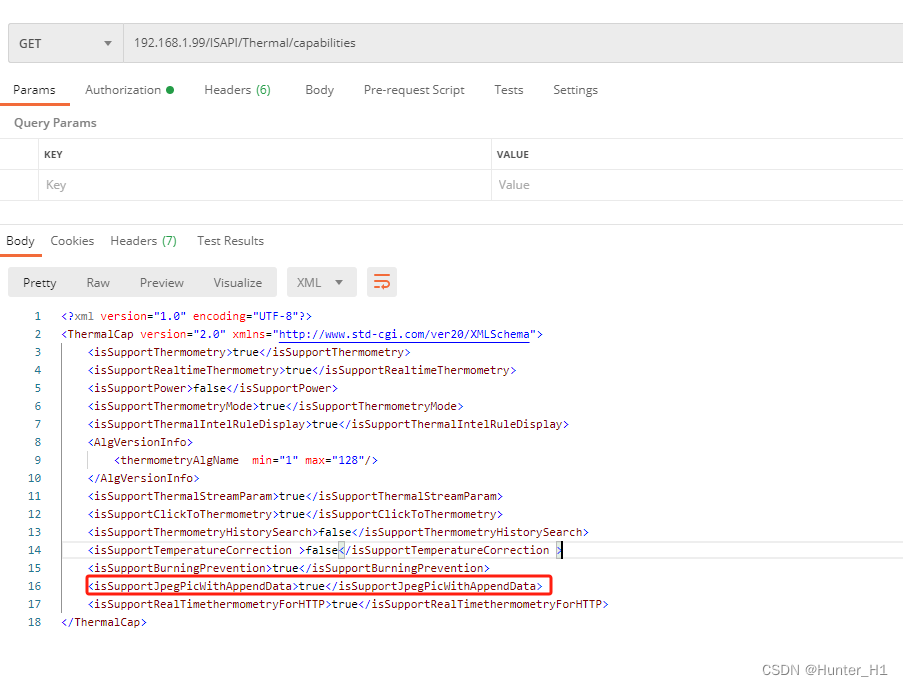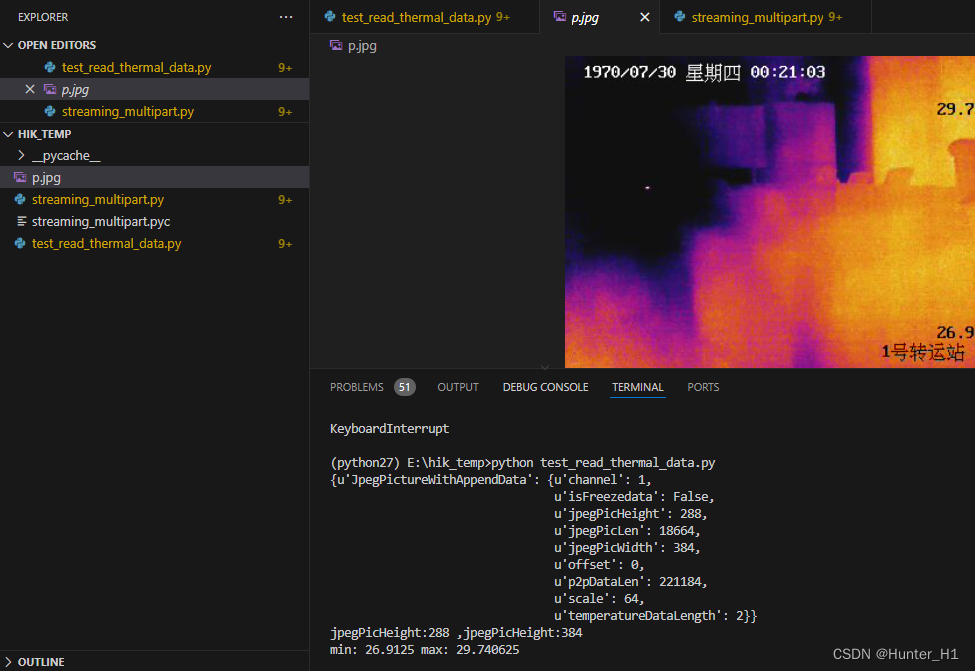本文基于ISAPI的jpegPicWithAppendData API获取相机实时温度,能够获取红外像素的全部温度。基于ISAPI通过HTTP的方式获取数据,不需要引入相机SDK,开发集成成本较低.
前置条件
判断相机是否支持JpegPicWithAppendData接口:

multipart解析程序
JpegPicWithAppendData接口基于http multipart进行数据传输,需要引入Python multipart解析程序,本文采用https://github.com/rckclmbr/streaming_multipart 获取http multipart 文件流,源码如下:
#!/usr/bin/python
# file: stream_multipart.py
"""
A streaming multipart content reader. Unlike every other multipart streaming library,
contents aren't cached to a file, or stored in memory.
https://github.com/rckclmbr/streaming_multipart
"""
import requests
from io import BufferedReader
from cgi import parse_header
from mimetypes import MimeTypes
from mimetools import Message
from cStringIO import StringIO
import hashlib
__version__ = "1.0"
BLOCK_SIZE = 4096
def _new_part(mr):
bp = Part(mr)
bp.populate_headers()
return bp
def skipLWSPChar(b):
while len(b) > 0 and b[0] in [" ", "\t"]:
b = b[1:]
return b
class _Buff(object):
# A simple read buffer
def __init__(self, st=""):
self.st = st
self.buf = st
def read(self, n=None):
if n is None:
ret = self.buf
self.buf = ""
return ret
ret = buffer(self.buf, 0, n)
self.buf = buffer(self.buf, n)
return ret
def __len__(self):
return len(self.buf)
class _StreamWrapper(object):
# So that file objects can use the BufferedReader
def readable(self):
return True
@property
def closed(self):
return False
def readinto(self, b):
if hasattr(self._wrapped, "readinto"):
return self._wrapped.readinto(b)
size = len(b)
# print "readinto", size
buf = self._wrapped.read(size)
if not buf:
return
if len(buf) == 0:
return None
for i, c in enumerate(buf):
b[i] = c
# print len(b.tobytes())
return len(buf)
def __init__(self, wrapped):
self._wrapped = wrapped
def __getattr__(self, n):
# print n
return getattr(self._wrapped, n)
class _PartReader(object):
def __init__(self, p):
self.p = p
def read(self, d):
"""
Reads the body of the part, up to and including length "d".
"""
n = ""
p = self.p
try:
# If the buffer contains the length of data we need, just return it
if len(p.buf) >= d:
#print "Buffer has size %d, just reading %d bytes" % (len(p.buf), d)
return p.buf.read(d)
#print "Peeking %s from BufferedReader" % BLOCK_SIZE
peek = p.mr.buf_reader.peek(BLOCK_SIZE)
#print "length of peek:", len(peek), hashlib.md5(peek).hexdigest()
if p.bytes_read == 0 and p.mr.peek_buffer_is_empty_part(peek):
return "" # EOF
# * Search for the boundary. If it exists, return all bytes up to
# the boundary.
# * Only actually read up to bytes_in_buffer - sizeof(boundary),
# leaving a tail for the boundary check
n_copy = 0
found_boundary = False
idx = peek.find(p.mr.dash_boundary)
safe_count = len(peek) - len(p.mr.dash_boundary)
if idx != -1:
n_copy = idx
found_boundary = True
elif safe_count > 0:
n_copy = safe_count
elif idx == -1 and safe_count == 0:
# When the data isn't a boundary, but has the same length as the
# boundary, read more off the BufferedReader
#print "Reading %d bytes from BufferedReader into buffer" % n_copy
data = p.mr.buf_reader.read(len(peek))
p.buf = _Buff(p.buf.read() + data)
if n_copy > 0:
#print "Reading %d bytes from BufferedReader into buffer" % n_copy
data = p.mr.buf_reader.read(n_copy)
p.buf = _Buff(p.buf.read() + data)
#print "Reading %s bytes from buffer of size %s" % (d, len(p.buf))
n = p.buf.read(d)
return n
finally:
if n is not None:
p.bytes_read += len(n)
class MultipartReader(object):
"""
Reads a stream formatted as multipart/form-data. Provides each part as a
readable interface, avoiding loading the entire body into memory or
caching to a file.
Usage:
reader = MultipartReader(f, boundary)
part1 = reader.next_part()
print part1.form_name()
data = part1.read(1024)
"""
def __init__(self, stream, boundary=None):
b = "\r\n--" + boundary + "--"
stream = _StreamWrapper(stream)
self.buf_reader = BufferedReader(stream)
self.nl = b[:2]
self.nl_dash_boundary = b[:len(b)-2]
self.dash_boundary_dash = b[2:]
self.dash_boundary = b[2:len(b)-2]
self.dash_boundary_nl = "--" +boundary + "\r\n"
self.headers = {}
self.parts_read = 0
self.current_part = None
def iter_parts(self):
"""
Returns an iterator over the Parts in multipart/form-data.
Do not use if you're skipping the end of the data, as the last
iteration will seek to the end of the stream.
"""
part = self.next_part()
while part != None:
yield part
part = self.next_part()
def next_part(self):
"""
Returns the next Part in the stream. If a previous part was not read
completely, it will seek to the beginning of the next part, closing the
previous one.
"""
if self.current_part != None:
self.current_part.close()
expect_new_part = False
while True:
line = self.buf_reader.readline()
try:
is_EOF = self.buf_reader.peek(1)
except(ValueError):
is_EOF = ''
if len(is_EOF) == 0 and self.is_final_boundary(line):
return None
if self.is_boundary_delimeter_line(line):
#print "Creating new part"
self.parts_read += 1
bp = _new_part(self)
self.current_part = bp
return bp
if self.is_final_boundary(line):
return None
if expect_new_part:
raise Exception("expecting a new Part, got line %s" % line)
if self.parts_read == 0:
continue
if line == self.nl:
expect_new_part = True
continue
raise Exception("Unexpected line in next_part(): %s" % line)
def is_final_boundary(self, line):
if not line.startswith(self.dash_boundary_dash):
return False
else:
return True
# rest = line[len(self.dash_boundary_dash):]
# rest = skipLWSPChar(rest)
# return len(rest) == 0 or rest == self.nl
def is_boundary_delimeter_line(self, line):
if line.startswith(self.dash_boundary):
rest = line[len(self.dash_boundary):]
rest = skipLWSPChar(rest)
if self.parts_read == 0 and len(rest) == 1 and rest[0] == "\n":
self.nl = self.nl[1:]
self.nl_dash_boundary = self.nl_dash_boundary[1:]
return rest == self.nl
return False
# if not line.endswith(self.dash_boundary_nl):
# return False
def peek_buffer_is_empty_part(self, peek):
if peek.startswith(self.dash_boundary_dash):
rest = peek[len(self.dash_boundary_dash):]
rest = skipLWSPChar(rest)
return rest.startswith(self.nl) or len(rest) == 0
if not peek.startswith(self.dash_boundary):
return False
rest = peek[len(self.dash_boundary):]
rest = skipLWSPChar(rest)
return rest.startswith(self.nl)
class Part(object):
"""
Represents a Part of a multipart/form-data. This is never instantiated
directly, but returned as part of the MultipartReader.next_part method.
"""
def __init__(self, mr):
self.buf = _Buff() # Buffer
self.mr = mr # Reader
self.r = _PartReader(self) # PartReader
self.bytes_read = 0
self.disposition = ""
self.disposition_params = {}
self.headers = {}
self.closed = False
def close(self):
""" Flushes the stream to the end of the part, so the next one can be started """
# Empty the stream, so the next part can be accessed
while True:
line = self.read(BLOCK_SIZE)
if line == "":
break
self.closed = True
def populate_headers(self):
line = None
while not line:
line = self.mr.buf_reader.readline().strip()
while line != "":
self.headers.update(Message(StringIO(line)))
line = self.mr.buf_reader.readline().strip()
def form_name(self):
""" Returns the name of the element, as used in a form"""
if not self.disposition_params:
self._parse_content_disposition()
return self.disposition_params["name"]
def file_name(self):
""" If a file upload, returns the filename """
if not self.disposition_params:
self._parse_content_disposition()
if "filename" in self.disposition_params:
return self.disposition_params["filename"]
def _parse_content_disposition(self):
if "content-disposition" in self.headers:
v = self.headers["content-disposition"]
params = parse_header(v)
key, values = params
self.disposition_params.update(values)
def read(self, d=None):
""" Reads d bytes from the body of the part. If the end, and empty string will be returned """
if self.closed:
raise IOError("Part already closed")
if d is None:
data = ""
while True:
d = str(self.r.read(BLOCK_SIZE))
if len(d) == 0:
break
data += str(d)
return data
else:
return str(self.r.read(d))
def readline(self):
raise NotImplementedError()
# if __name__ == "__main__":
# boundary = "----------------------------205472a3c0e0"
# f = open("test_post.http", "rb")
# reader = MultipartReader(f, boundary)
# with open("test.out", "wb") as outfile:
# for i in range(2):
# part = reader.next_part()
# print "name: " + part.form_name()
# if part.form_name() == "name":
# print "data: " + part.read(14)
# elif part.form_name() == "file":
# data = part.read(100)
# print data
温度获取程序
JpegPicWithAppendData接口返回的数据包括Json,jpeg二进制文件和温度二进制数组三部分,解析程序如下:
#!/usr/bin/python
# author: jsnjhhy@126.com
# coding: utf-8
# file: test_read_thermal_data.py
from io import BufferedReader
from streaming_multipart import MultipartReader
import requests
import struct
from requests.auth import HTTPDigestAuth
import json
import pprint
USR = 'admin'
PWD = 'li123123'
ROOT_URL = 'http://192.168.1.99'
if __name__ == '__main__':
hik_request = requests.Session()
hik_request.auth = HTTPDigestAuth(USR, PWD)
url = '%s/ISAPI/Thermal/channels/1/thermometry/jpegPicWithAppendData?format=json' % ROOT_URL
response = hik_request.get(url,stream = True)
reader = MultipartReader(BufferedReader(response.raw), "boundary")
#JSON PART
json_part = reader.next_part()
description = json.loads(json_part.read())
pprint.pprint(description)
jpegPicHeight = description['JpegPictureWithAppendData']['jpegPicHeight']
jpegPicWidth = description['JpegPictureWithAppendData']['jpegPicWidth']
p2pDataLen = description['JpegPictureWithAppendData']['p2pDataLen']
temperatureDataLength = description['JpegPictureWithAppendData']['temperatureDataLength']
if temperatureDataLength == 2:
scale = description['JpegPictureWithAppendData']['scale']
offset = description['JpegPictureWithAppendData']['offset']
print("jpegPicHeight:{h} ,jpegPicHeight:{w} ".format(h=jpegPicHeight,w=jpegPicWidth))
#JPEG PART
jpeg_part = reader.next_part()
jpeg_pic_raw = jpeg_part.read()
with open('p.jpg','wb+') as out:
out.write(jpeg_pic_raw)
#temperatureData PART
temp_part = reader.next_part()
temp_raw = temp_part.read()
res = []
for i in range(jpegPicHeight):
for j in range(jpegPicWidth):
dataIdx = (i*jpegPicWidth + j)*temperatureDataLength
if(temperatureDataLength == 2):
data_raw = temp_raw[dataIdx:dataIdx+temperatureDataLength]
temp_short = struct.unpack_from('1h',data_raw)[0]
print("temp_short:",temp_short)
temp = temp_short/float(scale) + float(offset) - 273.15
res.append(temp)
elif(temperatureDataLength == 4):
data_raw = temp_raw[dataIdx:dataIdx+temperatureDataLength]
temp = struct.unpack_from('1f',data_raw)[0]
res.append(temp[0])
print("min: {min_temp} max: {max_temp}".format(min_temp=min(res),max_temp=max(res)))
运行环境及运行结果
由于采用的streaming_multipart库较老,本文仍采用Python 2作为Python版本,对streaming_multipart进行修改或采用其他multipart类库,可将上述程序升级到Python 3.
运行代码:
python test_read_thermal_data.py结果如下:






















 5846
5846

 被折叠的 条评论
为什么被折叠?
被折叠的 条评论
为什么被折叠?








